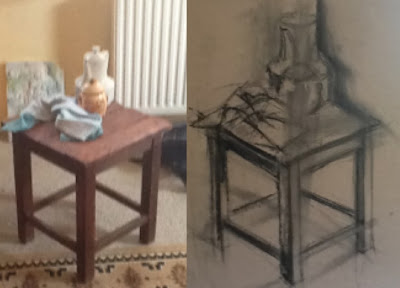Recently--to regain the balance of my brain hemispheres XD--I enrolled in one-to-one drawing lessons. (I'm an EFL teacher doing loads of one-to-one, so it is quite a flipped state for me.)
So .... there I was standing, situation reversed: normally I am the expert, my student the layman... Feeling excited and somewhat intimidated (:D) in the claws of my drawing instructor, who is my student :)
She put up a sheet of paper on the easel, brought in a little stool with a teapot, a little pot and a tea towel ('drapery' the professional term).
In the following 90 minutes I learned far more than how to draw that still-life. I lived through what my (adult) students are exposed to when being taught a completely new language, plus a lot of other things.
1
Give it up, it's tiring...............lucky there's commitment!
I got down to it with the promise of learning a new skill by putting myself into the caring hands of my instructor, I thought she would just take me by the hand, I'd close my eyes and let myself be dragged along the road to become a skillful hobby artist. Oh my, I hope my students don't expect anything like this! There is not one single conveyor-belt method of learning something. A teacher can indeed serve as a kind of scaffolding, also a witness of your commitment to learning, learning however happens within the learner.
Good to have a someone who is willing to come along and help or shares your commitment.
What helps YOU carry on doing something new?
2
I learned to see
Before the act of drawing the first line Moni, my instructor told me to have a look at the whole still life at least three times before I touch the paper. She said I was supposed to see the structure of it all, not just the surface. I was just watching and watching it but I still didn't know what she meant. ... I HAD to start drawing, I couldn't just stand there for 90 minutes! I sketched the vertical lines, then as I was watching the stool it just started to clear out somehow. This is like a listening comprehension task. First you have no clue, then you work on it and then there comes the meaning and you complete he puzzle from pieces you have in your head. Gestalt, nothing new, but striking. Many of my students either want only the logics behind the language (structure) and there are the ones who are willing to mime everything, it's not so much the structure that move them :). One cannot be without the other. It's good that you know the structure but not enough if you don't draw anything on your sheet. And if you just copy the parts you see not caring about the structure ...mmmm ...that is a nice picture but it might look like falling apart, very difficult to carry on drawing.
Do YOU always see the the inside and the outside as well?
3
Fear of failure
It was mere luck that for a while I did OK. Then I started to be afraid that I'd spoil it all with a bad line. Moni said I had nothing to worry about, just use the rubber any time. She was right, which didn't comfort me. I was still scared and somewhat discouraged. Hey! I thought I'd learned the value of failure (plus I learned the communicative approach inside out:)))) I'd thought fear of failure never affected me. Mistake.
Do you know the feeling when you rather don't do things just to avoid failure? I didn't remember, this lesson was a good reminder, maybe my students feel the same? U-huh! Of course I read about it, but feeling it ... Do YOU ever feel it?
4
Step back
I was just struggling with the picture when Moni told me to step back and see it from two steps behind. Wow! It was great! Many times I hear learners asking me if they are improving at all. Tests are good (?) , but when you are in the middle of something you often can't see your progress. How to step back when learning English?Trying to understand authentic stuff, trying to use it sometimes may do. Any idea?
5
Go back to the start
When I stepped back I also saw that it had happened: I just ... drew the teapot much bigger than it was in reality. Faaiilluurree! (The feeling wasn't as bad as I'd expected, anyway.)
Right. What to do now? There are two options. One is that I don't touch it, go on drawing, it will be a nice picture anyway, we can always say that the original teapot was this big, no one will check it. The other option is, I get the rubber, draw that part again (ruining existing good lines and investing another portion of energy and time in it). Booohoooo.
Finally I chose the latter one. I erased great lines, started again. What I won was a teapot more similar to the one on the stool. Also there were new lines not worse than the ones I cleared. I got some more practice on how to draw that teapot.
What happens when it turns out that something that YOU spent so much energy on just turns out to be ...hmmm... bad? Do you confess? Do you try to make it look nicer? When I was a beginner teacher I tended not to interfere with some of my students' strategies that I found ineffective or simply bad. I just didn't feel confident enough. Do I "erase" anything now? Do YOU?
Go and learn something new if you can afford it :)



